Ready to earn recurring income? Discover 14 profitable info products you can start selling today to grow your online business.
Info products are digital products that let you share your knowledge with the world. This category includes things like ebooks, courses, and templates. Selling info products is one of the best ways to make money online.
This year, I’ve made $8,000 a month selling info products. Some creators are pulling in far more, but that’s still a solid stream of recurring, mostly passive income.
And the timing couldn’t be better—online education and digital knowledge-sharing are booming. The global e-learning market alone is projected to surpass $400 billion in the next few years.
It’s easier than ever to grow an audience and package your expertise into online offers—aka, info products. Platforms like Whop make uploading and selling your knowledge simple, so you can start generating revenue without the headaches of tech setup.
Let's take a look at what info products are, who can sell them, and 14 different types of info products you can launch today.
What is an info product?
An info product is simply a digital way to share your knowledge. It could be an ebook, a course, a workshop, or any format that delivers information through a screen.
Who can sell an info product?
If you're in a career and you've been doing that career for a long time, the next logical step is always going to be to teach others how to do what you do and create an additional source of income for yourself.
- Volky, Digital Nomad Community
Literally anyone can sell an info product. I’ve seen vets selling ebooks, huge enterprise businesses selling training spots, and cross-stitchers selling online courses.
That being said, it’s much easier to sell an info product if you already have an audience or if there’s a need for knowledge in your niche.
For example, I create info products for freelancers hungry for details about how they can grow their businesses, find clients, and make more money.
Here are some common types of people you’ll see selling info products:
- Creators. People with a pre-established audience on social media often create info products to add an income stream to their business.
- Developers. People with technical skills often create info products to share their knowledge.
- Freelancers. People who sell their time in exchange for money can benefit from creating an info product that can scale.
- Coaches. People who help others will often create info products to enhance their coaching services.
- Entrepreneurs. People with multiple revenue streams will often have a few info products in their library.
- Businesses. Sometimes, you’ll see bigger businesses selling info products to increase their reach with an entry-level offer.
To sell an info product, you need two things:
- Knowledge to sell. Do you have specialist skills? Is there a topic you know a lot about or have lots of experience with?
- A market to sell to. Is there a demand for your knowledge? Is there a decent-sized pool of potential buyers?
If you have those two things, you can sell an info product.
Are info products easy to sell?
Info products are easier to sell in comparison to, say, multi-module courses, huge online events, and high-ticket offers because they’re usually affordable and help a specific audience solve a specific problem.
This means you don’t need to spend a lot of time convincing people why they should part with a boatload of money.
But, it’s not simply a case of publishing an info product and watching the cash roll in. You’ll need to build an audience and establish your authority and expertise on the topic before people will happily buy from you.
Once you’ve built a loyal following, it’s much easier to sell info products because people already trust you.
That’s the hard bit. Building an audience takes time. But when it comes to the actual technical part of selling an info product, it’s very easy. With a platform like Whop, you can simply upload your info product into your whop and direct people to buy.
15 info product examples
You can package your knowledge into all kinds of formats. The right one depends on your audience and the subject you’re teaching.
Some topics are best explained through video courses (crocheting, for example), while others make more sense as worksheets, templates, or quick trainings.
To spark ideas, here are 15 different types of info products you can create.
1. Online courses
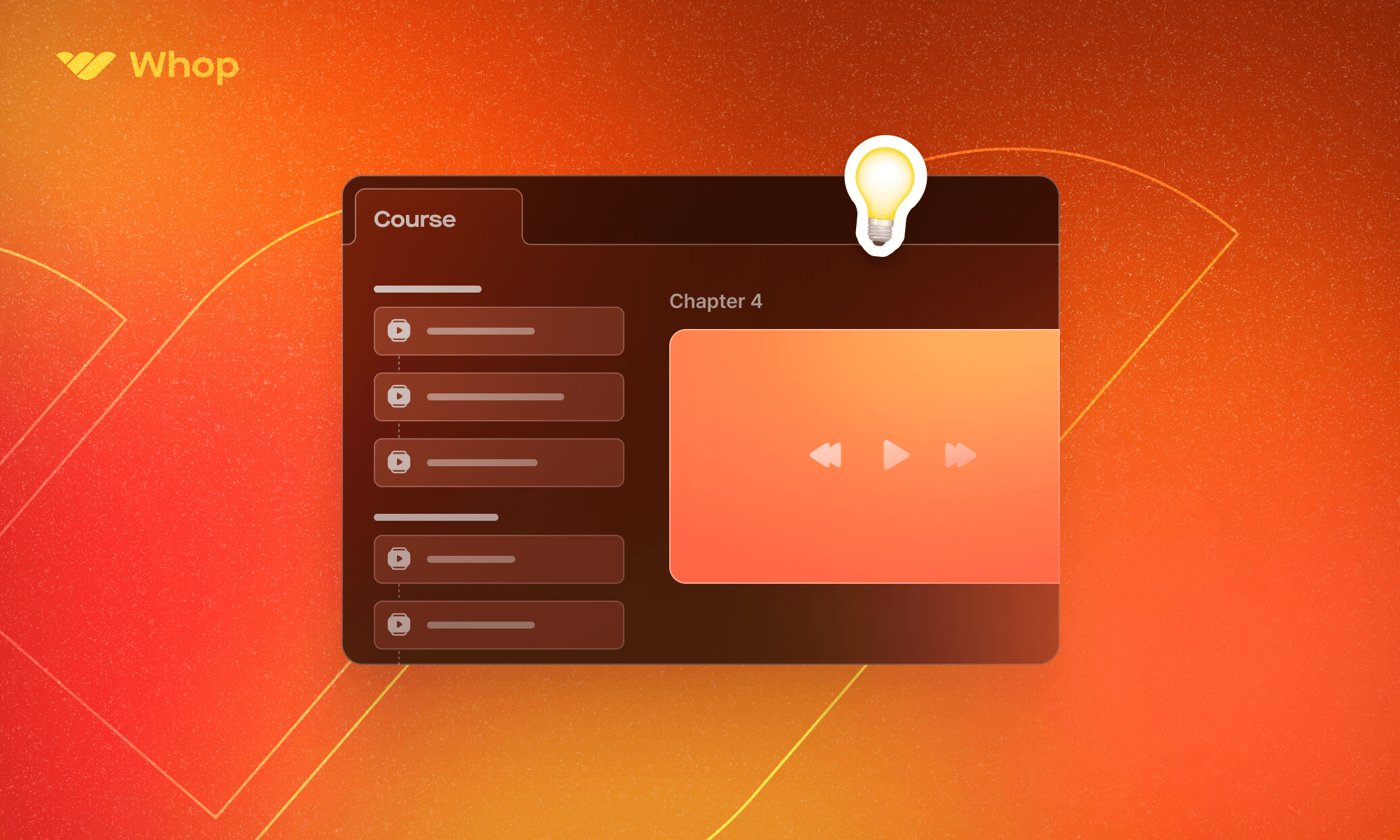
Online courses teach a specific topic either in one “masterclass” session or over a series of modules.
The goal is to drip-feed information to students who can then apply the knowledge elsewhere.
I’ve created many online courses over the years, and there’s one thing I’ll say: they take a lot of upfront time and energy.
Before you start selling seats, you need to have a solid curriculum, record individual lessons, and create any extras, like accompanying worksheets, activities, and quizzes.
How long does it take to create an online course?
It can take anywhere from a few hours to a few months. Writing scripts, recording videos, designing worksheets can easily stretch into weeks or even months if you’re building something big, like a 10-module coding program.
But now you don’t have to spend months creating. With AI tools to help you outline, script, and design materials, plus Whop’s online course builder to host everything, you could launch a simple, niche course in just a weekend — or even in a single day.
Whop makes it simple to upload modules, organize your curriculum, and build a professional-looking hub for your course. You can add community features like chat forums, layer in memberships for ongoing value, and scale up as your audience grows.
How much can you sell an online course for?
According to a study of over 130,000 course sales, the average price for an online course is about US$137.
Put depending on how in-depth and comprehensive the course is, you might charge less for a mini-course or more for a full, multi-module program.
For example, my first course was priced at US$189, and since then I’ve offered courses ranging from US$59 (smaller, more focused ones) up to US$299 (more comprehensive offerings).
2. Webinars

Webinars are live trainings that cover a specific topic in detail. They tend to dive deep into a small subsection of a wider topic, like “how to write content that ranks” or “how to confidently sell your coaching”.
The difference between most other info products and webinars is that webinars are live. You can pre-record them to share with buyers, but this method is more commonly known as video training or a workshop.
To create a webinar you need your topic and platform to host it on. A popular way to host webinars is via Zoom. You can share the link with people who have signed up and can take questions in the chat bar.

However, Zoom caps session times to 40 minutes, so if your webinar goes for longer than that then you have to pay for a Zoom subscription.
A great alternative is Whop, where you can host live webinars from your own whop!
How long does it take to create a webinar?
You can create a webinar relatively quickly. Because they’re live, you’ll want to limit the length of your webinar to keep people engaged.
If you have a topic in mind, you can create a presentation in a couple of hours.
The great thing about webinars is that, once you’ve created them, you can run them over and over again (or sell the recording).
How much can you sell a webinar for?
You can earn a healthy $500 to $3,000 per webinar. This varies depending on your topic and how many attendees you manage to secure. Similar data found the average cost per attendee for a paid webinar is around $48.
The added benefit of a webinar is live access to you. Most webinars have a Q&A section at the end where participants can ask questions and get them answered by you, the host.
3. Membership groups
I'm a professional Auto Cad trainer and I run the only land survey drafting community in the world.
- Jasen Hunt, Creator of Land Survey Drafting Community
Membership groups bring together people who want to learn about the same topic—like CAD training, as Jasen explains in the video above.
The membership group format usually follows a subscription model, where members pay a monthly fee for access to a library of info products, including live training, courses, and resources.
You can start with a handful of training and add new content each month, providing added value in the form of live sessions, one-to-one chats, and member forums.
To create a membership, you need a platform to host all relevant content. Whop lets you add different apps to your whop depending on what your members want and need.
For example, you can add a chat element for community conversation, a library of downloadables, and a place where members can access past trainings.

How long does it take to create a membership group?
The difference between a membership group and other types of info products is that you’ll have to keep creating additional content as time goes on. You want to continue to provide value for members so they continue to pay the monthly membership fee.
So the answer to this question is: how long is a piece of string? You can create and launch a membership program in minutes, but it takes ongoing effort to maintain it.
How much can you sell a membership group for?
Recent research from Mighty Networks (based on ~12,000 membership sites) shows the average membership or community fee is US$48/month. That’s up from about US$39/month in 2022-23.
Of course, there’s a wide spread: some memberships are priced lower, and others can go much higher — memberships on Whop sell for anything from $20 to $10,000 a month.
4. Live events

A live event is a series of talks, workshops, and webinars to create a virtual summit or an online conference. People pay a fee to attend talks happening over a day or two.
This is quite a time-intensive info product because you’ll need to plan the event upfront, which can be a logistical nightmare if you’re bringing external speakers in.
But, once you’ve run the live event once, you can replicate the format again and even sell recordings of the talks as separate info products.
How long does it take to create a live event?
The biggest time-suck of creating a live event is signing hosts to deliver talks and workshops. You can reduce some of this time by hosting all the sessions yourself, but you’re then faced with creating six, twelve, or even twenty different sessions, complete with slides.
It can take anywhere from one month to one year to create a live event, simply because there are so many moving parts involved.
But it might just pay off.
Live events are a great way to boost your standing in the industry and reach new audiences through your guest speakers.
How much can you sell a live event for?
There are two ways you can make money through live events:
- Selling tickets.
- Selling sponsorship slots.
Some live event hosts choose to keep ticket prices low and make up the difference by charging sponsors a set free to promote themselves at the event.
Tickets for live events can run anywhere between $20 and $20,000 depending on the caliber of speakers you have, the industry, and how many talks are available.
5. Worksheets

Worksheets are downloadables that solve a specific problem. For example, you might sell knitting patterns, content calendars, or printable journal prompts.
The idea is that each worksheet tackles one key topic to create an actionable, tangible result—e.g. A knitted top or a calendar full of relevant content ideas.
I’ve found selling worksheets particularly profitable because people often want a quick fix for a niggling problem.
I sell a series of templates and worksheets freelancers can use to create a slick client onboarding process and better manage multiple projects at once.
Worksheets can include (but aren’t limited to):
- Checklists
- Calendars
- Planners
- Trackers
- Templates
- Workbooks
- Lesson plans
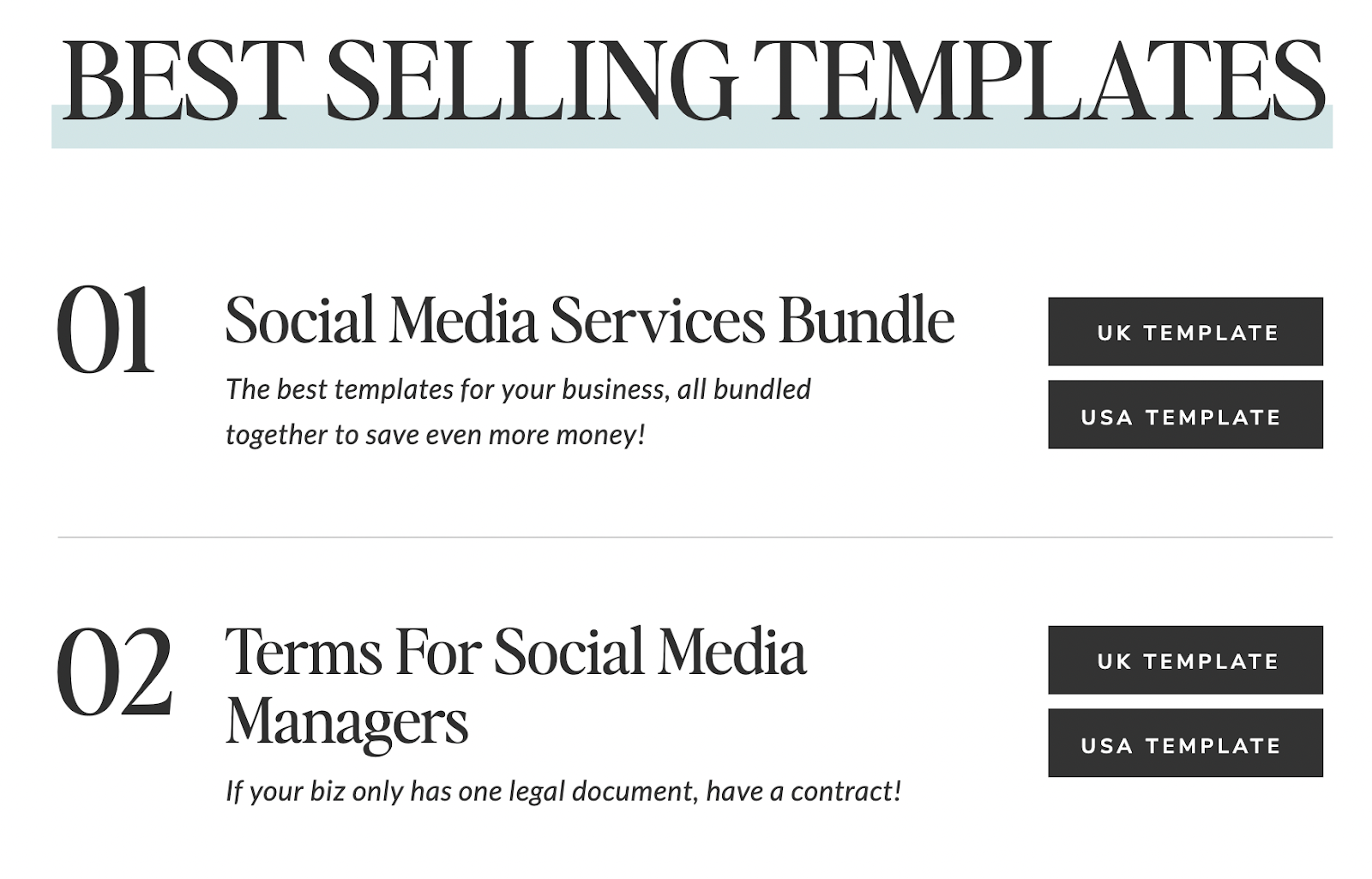
How long does it take to create a worksheet?
You can create a worksheet in seconds. Many of the templates in Workflow Wizard were created in less than a day—some were even created in less than five minutes.
If you know your subject well and have a clear idea of what you want people to achieve with your worksheets, you can crank them out relatively quickly. I’d say it takes anywhere from half an hour to a day to create a worksheet.
How much can you sell worksheets for?
I’m selling for the equivalent of $100, but that includes more than 10 worksheets and templates.
You can sell a single worksheet for as little as $5 depending on the complexity of it, or you can sell a bundle of worksheets for upwards of $25 (psa: you can sell both single products and bundles with Whop!).
These are often low-ticket items because they aren’t a comprehensive lesson in a subject—instead, they’re more of a quick win.
6. Ebooks
Jeremie Lander from Better Finance Today LLC
Ebooks are the original info product. They’re digital products that cover a specific topic in detail and can be downloaded, stored, and read on a computer, tablet, or mobile phone.
Unlike traditional books, ebooks don’t have to adhere to a specific word count—in fact, some ebooks are just 20 or so pages long.
Successful ebooks are both comprehensive, in that they dive deeper into a topic than a blog post, and digestible. To sell an ebook, you’ll need authority on your subject matter—just like an author would for a traditional, physical book.

How long does it take to create an ebook?
Depending on the depth of your topic, writing an ebook can take anywhere from 2–6 weeks. You can move faster if you already have a library of content to draw from.
For example, I once turned about 20 blog posts into an 80-page ebook — all I needed to do was add introductions for each section, plus an opening and closing chapter.
If you’ve been publishing blogs, newsletters, or even longform social posts, you can repurpose that content into a polished ebook. Just make sure everything ties together under a clear theme, and smooth out transitions so the flow feels natural.
And, AI can speed things up even more. You can use it to:
- Outline your ebook in minutes
- Summarize or expand existing content to fit chapters
- Polish transitions and tone so the book feels cohesive
That means what might have taken weeks in the past could now be drafted in just a few days.
How much can you sell ebooks for?
Ebooks usually sell for a lower price point than other info products, with the average selling price of non-fiction ebooks in the US sitting at $9.56.
When selling an ebook you should take into account the platform fees - for example, Amazon takes between 30 and 65% of your ebook sales, whereas Whop takes only 2.7%, meaning you get to keep a much larger portion of your earnings.
The great thing about ebooks is that, once you’ve written them (or compiled them) you can sell them over and over again.
7. Masterminds

Masterminds bring together a small group of people who have a similar goal. For example, you might create a mastermind that helps people create and sell a product or that helps them grow their business from $5k a month to $10k a month.
Usually, a mastermind will have regular calls or meetings that everyone can attend, but there might also be add-ons, like one-to-one sessions, workshops, and guest speakers.
Unlike memberships, masterminds tend to run for a limited period and charge participants a one-time fee.

How long does it take to create a mastermind?
The most time-consuming thing about creating a mastermind is becoming an expert on the topic you’re teaching.
Most mastermind hosts are at the top of their game and are well-known in the industry. But if you have the experience to lean on, you can create a mastermind relatively quickly.
All you need is a place to host your calls and resources (Whop’s hub format is great for this) and a plan for what you’ll cover in each mastermind call. Most masterminds run for several months (usually between six and 12 months), so you can plan out content as you go.
How much can you sell masterminds for?
Mastermind price tags tend to be high because they provide access to resources, training, and a network.
It’s not unusual to see mastermind prices starting at $5,000 for a year and some even go up to $50,000 or $80,000 a year.
8. Coaching
While coaching isn’t necessarily a digital product that can be downloaded, it does transfer knowledge from one person to another via a computer.
Online coaching sees trained coaches helping people figure out everything from their relationships and work life to growing a business or building a real estate portfolio.

How long does it take to create a coaching program?
If you have deep knowledge in a specific area and love to help people, online coaching might be the info product for you.
The best part is, that there’s not a lot of upfront work involved in actually creating your offering—however, the time-suck comes from spending years working in an industry and gaining the skills and knowledge you need to be qualified to coach others.
How much can you sell coaching for?
Studies show that coaches command an average hourly fee of $244, but this can vary. If you’re selling highly specialized knowledge, you can charge much more than this.
On the flip side, if you’re offering a leaner version of coaching, you can start with a lower price point and grow from there.
9. Newsletters

Newsletters are becoming an increasingly common way for people to own their list of customers. Sending regular emails to your audience builds trust and authority in your industry, but you can also make money from newsletters.
We’re starting to see more paid newsletters emerge as creators lock valuable information behind a pay well.
The paid newsletter model works similarly to subscriptions. Subscribers pay a monthly fee for access to exclusive content, sometimes once a month, sometimes once a week or more.

How long does it take to create a newsletter?
You can start a paid newsletter quickly. You’ll need an email marketing platform to collect emails and send your emails from, but other than that you can start writing and sending straight away.
It does take time to build an audience if you don’t have an existing network, but the beauty of this model is you can continuously grow your audience and your income.
How much can you sell newsletters for?
The 27 highest-earning newsletters make upwards of $22 million a year. Obviously, you won’t be hitting those numbers straight away (if at all), but the important thing to note is these newsletters aren’t expensive.
Subscribers pay anywhere from $5 to $20 a month to receive exclusive content.
The money is in the subscribers—the more you have, the more money you can make. For example, if you charge $5 a month and have 5,000 subscribers, that’s $25,000 a month.
10. Planners and journals

Any type–A person knows how handy it can be to have a planner or a journal to keep track of your schedule, your thoughts, and any little reminders you want to give your future self.
These fall under the umbrella of info products because they can be decked out with study tips, guides, and other things that make them useful instead of just pretty.
Downloadable templates are really popular info products among people who want to have control over exactly what their planner has and how many pages they need.
How long does it take to create a planner or journal?
It depends entirely on how complex you want it to be. A basic layout may take four to eight hours using a program like Photoshop or Canva, while something more complicated and detailed may take longer.
You can even take it further. If you want to create completely interactive digital planners, you can use a program like GoodNotes or Notability. These will take longer to make since they involve aspects that basic downloadables don’t, like user testing and hyperlinking; on the other hand, you can charge more for them, too.
(And remember—you can always use AI to speed up the process).
How much can you sell planners and journals for?
You can choose if you want to make templates that apply to a specific niche, which may require more research but also let you rack up the prices. If you’re only interested in ones for general use you can create more but charge less.
Basic printable planners and journals sell for anywhere between $2 and $20 a pop. Ones designed specifically for computer usage, like iPad or Kindle-sized, can sell for between $15 and $50.
A niche planner, like one designed for nutrition or fitness tracking, or ones that cater to a specific hobby, can sell for up to $100.
Once they’re made, these planners turn into passive income. The more of a variety you have available for sale in your shop, the more money you’ll be making in a month—and selling these is super easy if you make your own whop.
11. Presentation slide decks

Slide decks are a staple in both academic and corporate settings. The phrase actually harkens back to old-timey carousel slide projectors, but most of us just know these things as PowerPoints.
Slide deck or PowerPoint, it’s the same thing either way: a group of slides each containing information that comes together to form a presentation. You can create templates that people can customize with their own data.
How long does it take to create a presentation slide deck?
The length of time you spend on a slide deck depends on how many slides it’ll be and how complex the design you’re aiming for is. Just as a general ballpark, you can count on 15 simple slides taking around two to three hours.
If you make your own graphics for the slide deck, or you include more complicated elements like charts, graphs, animations, or formula-based elements, then it can take as much as four times that.
One final consideration: if you’re creating slide decks not as templates but as custom projects and making the entire thing for a specific client, then you may spend as much as 30 hours on it.
How much can you sell presentation slide decks for?
Much like timing, the price depends on how long you spend on it. Value your time as highly as you feel appropriate, and don’t undercharge just because the price seems intimidating.
You can sell basic templates on Whop for anywhere between $10 to $50.
But, if you create premium slide decks, don’t be afraid to charge between $100 and $500 depending on the demand and effort.
12. AI prompt libraries
I just spent the last hour compiling a list of the most profitable digital products that I can sell to make an extra $10k a month in my business, and one thing stood out more than the others: AI prompts
If you’re AI-savvy, you can create prompt libraries and sell access to them. A prompt library is basically just a curated collection of prompts you use with generative AI tools like Midjourney and ChatGPT.
This is a useful resource for people who want to use generative AI to get really specific results, but aren’t sure how to coax those results out of the tools themselves.
You can diversify your customer base by making prompt libraries targeted to different niches, like an art prompt library for creators, a copywriting prompt library for marketing and sales professionals, and business automation prompts for entrepreneurs.

How long does it take to create an AI prompt library?
To figure out how much time it’ll take you to make an AI prompt library, decide how many prompts you want to make.
Many prompt collections have tens of thousands of prompts, so that's going to take a fair bit of time—but you can sell them time and time again later, making them a good source of passive income.
Depending on the number of prompts, expect to spend anywhere between five and 30 hours on creating your final product.
Or, once again—use AI! You can use AI to create a library of AI prompts, drastically reducing your time (are you sensing a theme here?).
How much can you sell AI prompt libraries for?
To price your AI prompt library, consider how much time you spent making it and how valuable you think the prompts are to your intended demographic.
A small, generic prompt library might sell for between $10 and $50, while expertise-driven prompts (like for law professionals or marketers) might get you between $100 and $300.
You can also use a subscription model for libraries that you can plan on continually updating.
With Whop, you can easily set up a subscription, but you can also sell your prompts at a one-time fee.
13. Marketing playbooks
A playbook in business is just like a playbook on the sports field—it’s a guidebook that outlines the strategy for success and a winning game. This is especially useful for digital marketing!
You can make marketing playbooks that help people with a general overview of what they should be doing, or you can offer playbooks that teach people step-by-step how to master areas like:
- Social media marketing
- Email marketing
- SEO strategies
- Paid advertising

How long does it take to create a marketing playbook?
If you’re already a marketing whiz, the process of making a playbook will be a lot simpler—after all, you already know all this stuff.
For a basic playbook, this should take somewhere between 10 and 20 hours.
However, if you're going to dig deeper or you need to learn these things yourself first, it becomes quite the job with a lot more time required, ranging between 30 and 60 hours.
How much can you sell marketing playbooks for?
Basic playbooks generally sell for $30 to $100, but you can make yours a much more valuable resource if you bundle them with other products.
The idea is that an ebook alone won't contain everything a person might need in the fast-paced world of marketing.
Instead, bundle your ebook with one-on-one coaching or an exclusive marketing community and charge as much as $1,000 and more!
14. Meal plans
Meal plans are structured guides for what someone should eat for a specific end goal. This could be for weight loss purposes, to gain muscle, to help manage a medical condition, or to try and adhere to a specific diet (think vegan, keto, paleo, etc).
If you’re someone that has experience and knowledge about nutrition and how people should eat to meet these kinds of goals, then you can definitely make money selling meal plans online.
These are some of the most in-demand info products out there.

How long does it take to create a meal plan?
If you’re making a simple meal plan for someone without a lot of dietary requirements or preferences, the general rule is that it’ll take you around four hours.
If you have to factor in a specific diet, allergies, and food preferences, that's bound to take you longer. Remember to also include additional information like nutritional breakdown, macros, and extensive cooking instructions.
With all that extra work, a monthly meal plan may take up to 20 hours, but it's an evergreen product that you can sell again and again.
How much can you sell meal plans for?
Simple meal plans sell for between $10 and $50 on most platforms. More niche plans can get between $75 and $200, especially if you make custom plans based on one-on-one coaching with your clients.
You can also charge more for your meal plan if you have qualifications behind your name, like being a registered dietician or a fitness expert.
You can bundle the meal plan with other informational services, like coaching or fitness programs, and profit even more from the upsell.
15. Podcasts
Brett Malinowski, Head of Marketing at Whop
"Podcasting is a great online business to start, because not only can you make money from sponsors, you can also send traffic to your own digital products."
– Brett Malinowski, WGMI podcast
If you’ve got something to say (or you’re great at getting other people to talk), you can create a podcast and sell access to it as an info product. A podcast can be educational, story-driven, interview-based, or a mix, and your listeners get to learn on the go.
Private or paid podcasts are awesome because they offer exclusive content. Once you have a social media presence, people will be that much more likely to eat up all podcast/exclusive content you're willing to sell to them.
Podcasts are a great place to share expert insights, behind-the-scenes knowledge, industry tips, or personal development guidance. They pair very well with paid communities.
How long does it take to create a paid podcast?
This depends on how often you want to release episodes and how polished you want them to be.
A simple audio-first podcast with minimal editing can take up to 3 hours per episode, while a more scripted, research-heavy, or interview-style episode could take 4–8 hours. Editing is a skill to learn and later master, so you'll be slower at first, but you'll learn as you go.
Pre-recording podcast episodes is a good idea. You can have filming and recording days and then spread out the editing over a period of time.
How much can you sell a paid podcast for?
Podcasts can be priced per episode, but you can also sell lifetime or subscription-based access to the whole series. Either pricing works if you monetize your podcast with Whop.
The easiest way to charge good money for a podcast is to sell it as a way to supplement your other info products. You can reasonably charge $10 to $300 per month depending on how much value your podcast provides.
If you're an influencer or you have great tips that can't be found anywhere else, you can make really good money podcasting.
How and where to sell info products
Actually creating your info product is the easy part. You probably have a ton of knowledge that you can distill into an ebook, a course, or a worksheet.
The hard part is getting people to buy your info products, especially if you’re starting with a relatively small audience.
Here are some ways to promote your info product to get more sales.
Social media
Social media is the perfect place to grow a loyal following. Some creators start building their audience before they sell their info product, while others create the info product first and then use it to grow their following.
Promoting your info product on social media involves a certain amount of creativity. You want to convey your skills and knowledge without giving too much away.
Maha Copy does this well. The duo owns a copy shop full of paid ebooks and worksheets. They highlight their expertise via engaging Instagram posts and then direct people to the copy shop where they can get a discount.
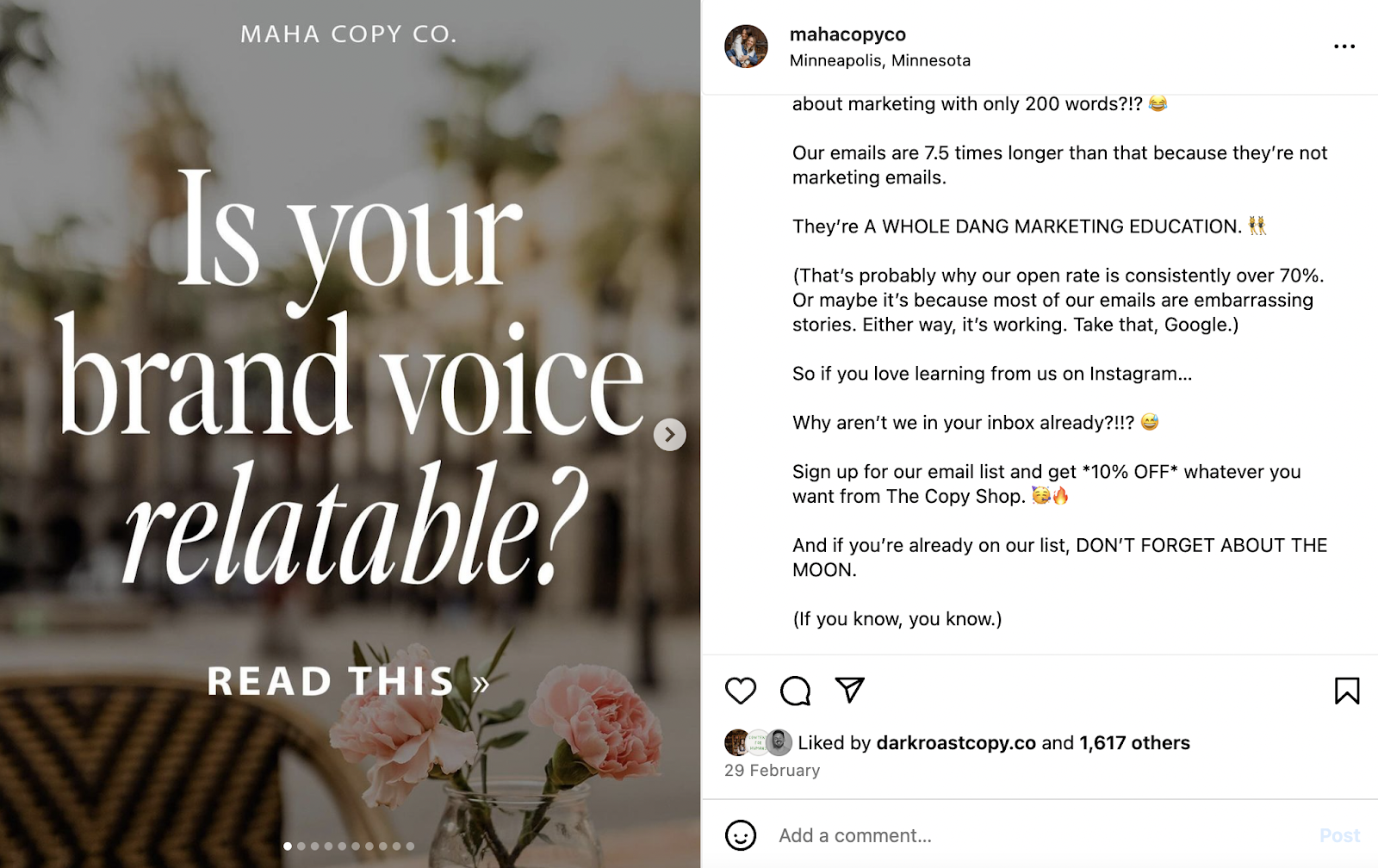
Here are some ways you can promote your info product on social media:
- Create Instagram Reels that give followers a sneak peek into what they can expect.
- Share testimonials from previous customers to build social proof.
- Use calls-to-action in your captions to direct people to your info product.
- Explain what people will get out of your info product by highlighting the benefits over the features.
- Create eye-catching graphics for your info product.
- Add a link to your info product to your social media profiles.
Affiliate marketing
Affiliate marketing involves recruiting relevant industry creators to share your info product with their audience. For every sale made through their unique link, the creator gets a slice of the commission. This can be a great way to reach a wider audience and transfer trust from other creators to your brand and products.
Making money through affiliate marketing has never been easier than it is now, all thanks to Whop.
As the owner of your own whop, you can encourage your followers to advertise your whop for you—they'll receive a cut out of each sale.
Make it easier for affiliates to promote your product by giving them pre-written copy and graphics.
Email marketing
Email subscribers are often the most loyal followers because they’ve entrusted you with their inbox. You can share your info products throughout your emails, whether it’s a dedicated email highlighting testimonials and case studies or just a one-line promotion at the end of a weekly newsletter.
I promote my info products in every newsletter. I have a dedicated section at the top of each email that spotlights all three of my info products and links out to them, so it’s often the first thing subscribers will see.
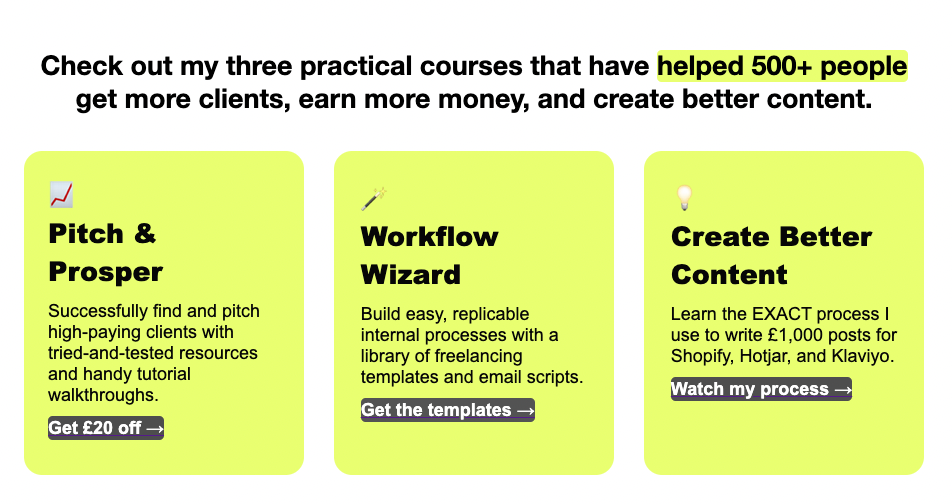
Sell on a platform
While social media, affiliate marketing, and email marketing are all great for generating a buzz around your info product and introducing it to new customers, selling it on a dedicated platform is an even better way to get it out there.
Platforms like Whop make creating an entire ecosystem around your info product easy, including extras like forums and email sequences.
When you join the marketplace then your products are visible to people actively searching for what you’re offering. This ultimately makes it much easier to convert customers because they are already looking for something like your info product.
Why Whop is the best place to sell info products
Whop gives you everything you need to sell courses, ebooks, communities, masterminds, newsletters, and more — all from one place.
Your whop is fully customizable with built-in apps for chat, forums, newsletters, course modules, file sharing, events, and even video. Add as much or as little as you need to grow your business.
You can sell one-off products or set up subscriptions for recurring revenue.
And the best part? Whop is free to start. You only pay a small cut when you make a sale — no upfront costs, no risk.
Info product FAQs
How to create info products fast
The easiest way to create info products quickly is to utilize your existing content. For example, if you already have tons of blog posts on your website, you can bring them together in an ebook. Alternatively, you can opt for an info product that doesn’t require much upfront effort, like coaching or paid newsletters.
What’s the best info product to sell?
The best info product is the one best suited to your business and audience. Here are the most common types of info products:
- Online courses
- Ebooks
- Webinars
- Memberships
- Worksheets
- Newsletters
How much money can I make selling info products?
You can make decent money selling info products if you create something your audience needs and is willing to pay for. Some info products demand higher price tags than others.
For example, masterminds typically sell for a minimum of $5,000, while ebooks usually fall somewhere between $5 and $20.


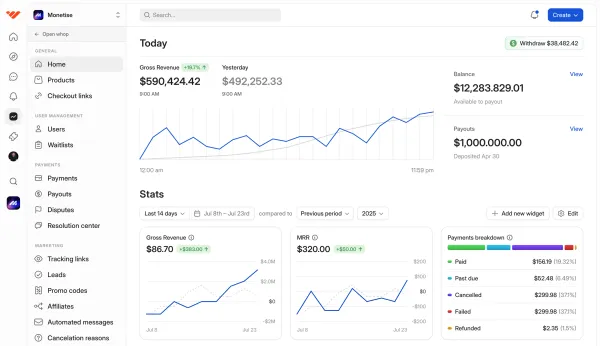
![How to sell digital products without a website - ultimate guide [2026]](/blog/content/images/size/w1000/2024/02/How-to-Sell-Digital-Products.webp)



![Where to sell digital products [2026]](/blog/content/images/size/w1000/2023/11/Where-To-Sell-Digital-Products.webp)






